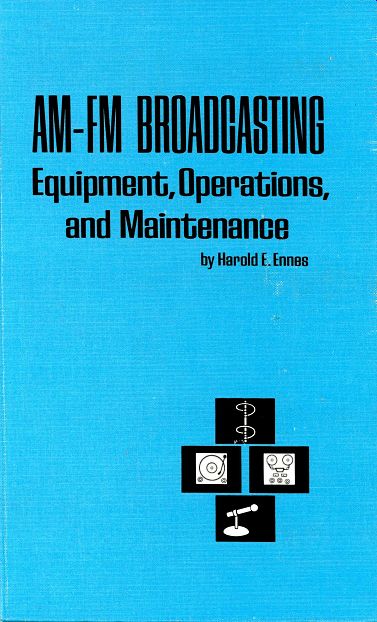
- ORIENTATION IN AM-FM BROADCASTING
- MATHEMATICS REVIEW FOR BROADCAST ENGINEERING
- SEMICONDUCTORS AND LOGIC FOR BROADCAST ENGINEERS
- THE FUNDAMENTALS OF TRANSDUCERS
- THE MAGNETIC TAPE SYSTEM
- THE MONAURAL STUDIO AND CONTROL ROOM
- THE STEREO CONTROL ROOM, QUADRAPHONIC SYSTEMS, AND AUTOMATION
- MOBILE AND FIELD FACILITIES AND STL's
- AM TRANSMITTERS AND ANTENNA SYSTEMS
- FM TRANSMITTERS AND ANTENNA SYSTEMS
- STUDIO OPERATIONS
- REMOTE PICKUP OPERATIONS
- STUDIO MAINTENANCE
- TRANSMITTER OPERATIONS AND MAINTENANCE
- ANSWERS TO EXERCISES
Preface:
Radio broadcasting is a highly specialized branch of electronics. Those who study for and take the examination for the FCC radiotelephone first class operator license soon realize that their knowledge is incomplete when they assume the duties of actual broadcast operation. This text is intended for all who need a practical insight into the use of electronic circuitry as applied specifically to broadcasting.
The reader of this guide must already have basic electronic training. However, advanced electronic training on a university level, while helpful, is not required.
The first ten Sections make up the engineering section of the text. This section is not intended as a design course for broadcast equipment; rather, it presents the engineering fundamentals needed by the chief engineer or maintenance technician, or trainee for these positions, of an am and/or fm broadcast station. Therefore, the design of networks for impedance-matching or bridging circuitry is included. A knowledge of mathematics at the high-school level is assumed, although a refresher course is included for reference.
The final four Sections are designed to answer the question, "I know the theory; now what do I do on the job?" The basic technical theory of radio broadcasting has remained essentially the same, but great advances have been made in the development of equipment and operations. These improvements have outmoded many techniques. Thus, the last Sections are devoted to a discussion of modern station operations.
In preparing the content, I have deliberately avoided tying down specific procedures to specific FCC rules. It is the duty of every engineer who is responsible for compliance with such rules (normally the chief engineer of the station) to subscribe to current FCC rules about broadcasting and to keep abreast of changes that occur. Therefore, whenever FCC rules are mentioned as examples, it must be understood that the presentation is for illustrative purposes only and is not necessarily the latest ruling of the Commission.
When maintenance and engineering personnel require a quick and easy reference, the extensive subject breakdown in the text and the complete index will prove helpful. Preventive maintenance and proof-of-performance testing are given full coverage.
An effort has been made to compile data which the broadcast engineer frequently needs but for which he must usually consult numerous sources.
It is hoped that this volume will serve both as an informative text and as a useful reference source.
The author is indebted to the following for important contributions to this guide: American Broadcasting Co.; CBS Laboratories; CCA Electronics Corp.; Electrodyne Co., Inc.; Gates Division Harris-Intertype Corp.; General Electric Co.; Marti Electronics, Inc.; Metron Instruments, Inc.; National Broadcasting Co.; RCA; Sansui Electric Co., Ltd.; Schafer Electronics Corp.; Sony Corp.; TelePro Industries, Inc.; and the 3M Co.
- HAROLD E. ENNES
Also see:
Foundations of Communication Theory